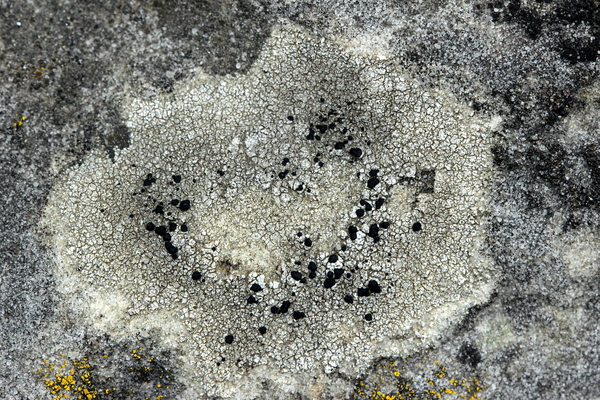Carbonea latypizodes (Nyl.) Knoph & Rambold
in Hertel, Sendtnera, 7: 96, 2001. Basionym: Lecidea latypizodes Nyl. - Flora, 57: 12, 1874.
Synonyms: Lecidea lacteola Nyl.; Lecidea liguriensis H. Magn.; Lecidella lacteola (Nyl.) Hertel & Leuckert
Distribution: N - TAA, Lomb, VA (Piervittori & Isocrono 1999), Lig (Giordani & al. 2016).
Description: Thallus crustose, sometimes indistinct, usually thinly episubstratic, granulose or rimose- areolate 0.1-1 mm thick, often delimited by a dark prothallus, the areoles 0.2-0.6(-2.4) mm wide, white, rough. Medulla I-. Apothecia lecideine, glossy black, sessile, 0.5-0.7(-1) mm across, with a flat to convex, epruinose disc, and a prominent, usually persistent, strongly flexuose proper margin. Proper exciple blue-green in outer part, dark brown within; epithecium bright green to blue-black, N+ purple-red; hymenium colourless or rarely greenish in upper part, 45-70 µm high, inspersed with oil droplets; paraphyses rather loose, distinctly thickened at apex; hypothecium pale orange-brown or yellowish brown, rarely colourless. Asci (4-)8-spored, clavate, the K/I+ blue tholus penetrated by a faintly amyloid apical cushion with parallel or diverging flanks, the outer wall very thin, K/I-, surrounded by a K/I+ blue outer layer, Lecanora-type. Ascospores 1-celled, hyaline, ellipsoid, 8-15 x 4-8 µm. Pycnidia globose, immersed. Conidia thread-like, 10-20 µm long. Photobiont chlorococcoid. Spot tests: thallus K- or K+ faintly yellow, C-, KC-, P-. Chemistry: atranorin and 2'-O-methylperlatolic acid.Note: an early coloniser of small pebbles in dusty situations, especially near the ground, with a wide altitudinal range.
Growth form: Crustose
Substrata: rocks
Photobiont: green algae other than Trentepohlia
Reproductive strategy: mainly sexual
Pioneer species
Commonnes-rarity: (info)
Alpine belt: absent
Subalpine belt: rare
Oromediterranean belt: absent
Montane belt: rare
Submediterranean belt: very rare
Padanian area: absent
Humid submediterranean belt: absent
Humid mediterranean belt: absent
Dry mediterranean belt: absent

Predictive model
Herbarium samples
Growth form: Crustose
Substrata: rocks
Photobiont: green algae other than Trentepohlia
Reproductive strategy: mainly sexual
Pioneer species
Commonnes-rarity: (info)
Alpine belt: absent
Subalpine belt: rare
Oromediterranean belt: absent
Montane belt: rare
Submediterranean belt: very rare
Padanian area: absent
Humid submediterranean belt: absent
Humid mediterranean belt: absent
Dry mediterranean belt: absent

Predictive model
| Herbarium samples |
 INDEX FUNGORUM
INDEX FUNGORUM
 GBIF
GBIF
 DOLICHENS
DOLICHENS


